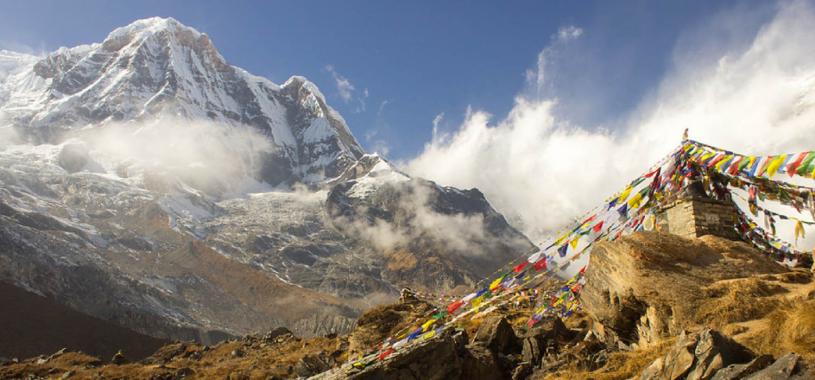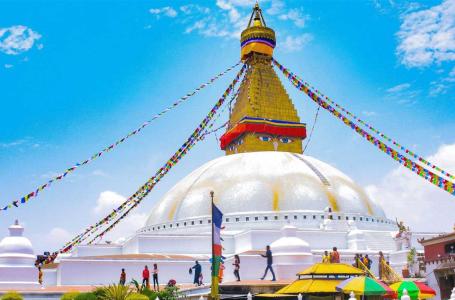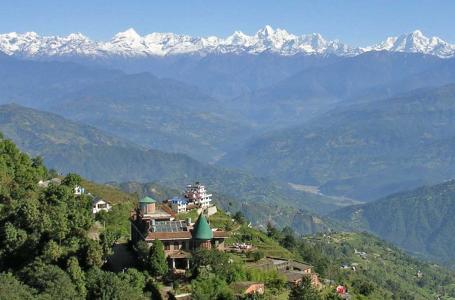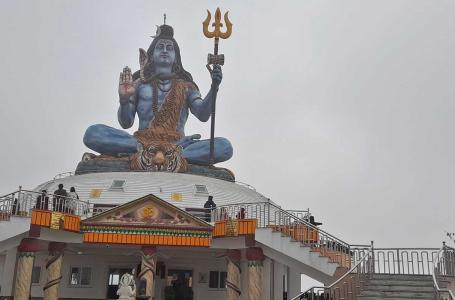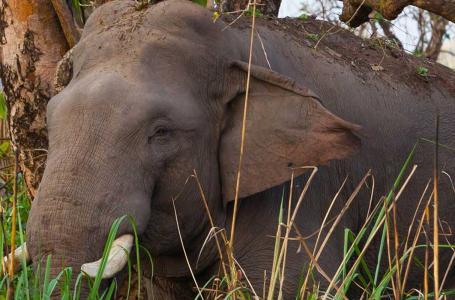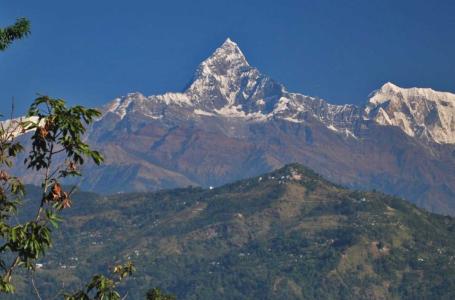- 01Pax USD 2450 pp
- 02 to 05 Pax USD 2275 pp
- 06 to 10 Pax USD 2140 pp
- 11 to 15 Pax USD 1950 pp
Itinerary
Welcome to Nepal! Upon arrival at Tribhuvan International Airport in Kathmandu, our team will greet you and transfer you to your hotel. Take the rest of the day to relax and explore nearby areas. Overnight in Kathmandu.
Today, explore Kathmandu’s UNESCO World Heritage Sites, including Swayambhunath (Monkey Temple), Pashupatinath Temple, and Kathmandu Durbar Square. In the afternoon, meet your guide for a briefing and gear check for the trip. Overnight in Kathmandu.
Enjoy a scenic drive to Pokhara, a beautiful lakeside city. Marvel at stunning views of rivers, hills, and local villages along the way. Upon arrival, spend the evening by Phewa Lake. Overnight in Pokhara.
Drive to Nayapul (1.5 hrs) and begin trekking through lush forests and terraced fields. Reach the charming Gurung village of Ghandruk, where you'll enjoy stunning mountain views. Overnight in Ghandruk.
Descend to Kimron Khola and ascend to Chomrong, a picturesque village at the gateway to the Annapurna Sanctuary. Relish the views of Annapurna South and Machhapuchhre (Fishtail). Overnight in Chomrong.
Descend to Chomrong Khola and climb through rhododendron and bamboo forests to Dovan. The trail offers serene landscapes and a tranquil environment. Overnight in Dovan.
Ascend through a rocky trail surrounded by alpine vegetation to Machhapuchhre Base Camp (MBC). Enjoy panoramic views of Annapurna, Gangapurna, and Machhapuchhre. Overnight in MBC.
A relatively short trek brings you to Annapurna Base Camp (ABC). Be mesmerized by the 360-degree views of towering peaks, including Annapurna I and Hiunchuli. Overnight at ABC.
Take the day to acclimatize and prepare for the upcoming climb. Explore the base camp, practice basic climbing techniques, and soak in the majestic surroundings. Overnight at ABC.
Trek across glacier moraines and rugged trails to Tent Peak Base Camp. Enjoy close-up views of Tent Peak and other surrounding giants. Overnight at the base camp.
Ascend to Tent Peak High Camp, navigating steeper trails and snowy ridges. This is a challenging but rewarding day as you prepare for the summit. Overnight at High Camp.
Start early for the summit push. Climb through steep snowfields and ridges to reach the summit of Tent Peak. Enjoy panoramic views of Annapurna, Dhaulagiri, and Nilgiri ranges. Descend to Base Camp for rest. Overnight at Base Camp.
Retrace your steps to Annapurna Base Camp, reliving the stunning views along the way. Celebrate your successful climb with fellow trekkers. Overnight at ABC.
Descend to Bamboo through lush forests, enjoying the beauty of the Annapurna Sanctuary. Overnight in Bamboo.
Trek to Jhinu Danda and relax at the natural hot springs by the Modi Khola. This is a perfect spot to rejuvenate your tired muscles. Overnight in Jhinu.
Walk through terraced fields and forests to Potana, a quiet village with fantastic views of the Annapurna range. Overnight in Potana.
Trek down to Kande, where your vehicle awaits to drive you back to Pokhara. Spend the evening relaxing in the lakeside city. Overnight in Pokhara.
Return to Kathmandu by tourist bus or private vehicle. Enjoy the scenic journey back to the capital. Overnight in Kathmandu.
Our team will transfer you to the airport for your departure. Take with you unforgettable memories of this incredible adventure.
Overview
Tent Peak (5663 m / 18580ft), famous as Tharpu Chuli is a popular trekking peak situated in the north-western region of Neal. The top of the mountain is like a shape of a tent and due to this, it is commonly known as Tent Peak. It sits in the Annapurna Sanctuary, north of Annapurna Base Camp.
Turning the pages of history, Tent Peak was climbed by Jimmy Roberts, one of the best climbers of the twentieth century, in 1956. Ever since that time, the peak has been a destination for both amateurs and professionals. Professionals seem to do this climb to acclimatize well before climbing Annapurna and other higher mountains of Nepal. Likewise, beginners have been attending this peak to gain some expertise to level up themselves.
This Tent peak climbing is best suited to those who intend to step up from trekking to amateur mountaineering. Tent Peak, also known as Tharpu Chuli offers a short trekking peak climbing experience - way beyond simply trekking. Of course, this trip includes the trek to the picturesque Annapurna Base Camp with a few days of peak climbing in the Annapurna region.
Tent Peak is a lower elevated peak and is not as challenging as Island Peak, Mera Peak, or Yala Peak. Tent Peak offers excellent short trekking and peak climbing experience, which aids in your further higher mountain climb expedition. Upon reaching the top of Tent Peak, we can have awe-inspiring views of the high mountains of the Annapurna and Dhaulagiri mountain ranges.
Planning:
A trip to Tent Peak, also known as Tharpu Chuli, takes extensive planning. Investigate the climbing route, obtain necessary permissions, and concentrate on physical preparation that includes cardiovascular fitness, strength, and endurance. It is critical to gather or rent climbing equipment such as ropes, harnesses, crampons, and adequate gear for varied weather situations. Hiring an experienced local guide is a must as solo travelling is banned in Nepal. You can easily hire a local guide from a reputable trekking agency. Before coordinating transportation to the trek's beginning site, arrange transit to Pokhara and secure lodgings. Next, rest days and altitude acclimation are essential along the climb to reduce the risk of altitude sickness.
Plan for permits, guide fees, equipment, lodging, food, and emergency expenditures. Prioritize a medical examination, buy comprehensive trip insurance that covers climbing and emergency evacuation, and follow conservation principles such as 'Leave No Trace.' It is critical to have dependable communication tools for emergencies to have a safer and more rewarding climbing experience in the Annapurna region.
The best time to do the Tent Peak Climbing?
Tent Peak, also known as Tharpu Chuli in Nepal's Annapurna area, is best climbed in the spring (March to May) and fall (September to November). Spring brings consistent weather with pleasant temperatures and bright sky, and brilliant rhododendrons and other blooms adorn the pathways, adding to the picturesque magnificence. This season provides excellent climbing conditions, with greater visibility and less precipitation.
Autumn follows the monsoon season, giving climbers with clear sky, steady weather, and fewer companion hikers on the routes, resulting in a tranquil and enthralling experience with breathtaking panoramic views. Both seasons provide ideal climbing conditions, making adventures safer and more pleasant. However, the decision between these seasons may also be influenced by personal preferences about weather patterns and general mountaineering.
Because of safety issues, technical challenges, and the overall severity of the weather and path conditions, ascending Tent Peak during the monsoon and winter seasons in the Annapurna region is less advised.
Foods and Accommodations:
A climbing trip to Tent Peak consists mostly of teahouses or lodges along the trekking route. These accommodations provide modest but necessary facilities, such as twin-bed rooms with communal toilets. Teahouses are social hubs where climbers may relax, mingle, and eat, and they occasionally have charging stations. Camping becomes increasingly popular when climbers reach higher elevations and get closer to Tent Peak Base Camp. Climbers can carry their camping equipment or hire it locally for greater freedom in putting up temporary campsites along the route. Climbing in this gorgeous environment provides a unique experience.
Meals at teahouses are mostly Nepalese foods such as dal bhat, noodles, rice, and veggies, with some Western-style food and hot beverages thrown in for good measure. Packed lunches, which often consist of sandwiches, boiled eggs, fruits, and energy bars, are essential for maintaining energy levels during the day's ascent. Given the remoteness and altitude, packing personal snacks such as trail mix or energy bars to complement meals is recommended. Accepting the simplicity of these facilities and local cuisine is part of the unique climbing experience in this gorgeous location.
It is always advised to consult with your guide for better food options.
Transportation:
The Annapurna Sanctuary Trek often begins at Nayapul or Phedi. If you want to fly to Pokhara, you can take a domestic airplane (30 minutes) or a tourist bus/private car to Pokhara (approximately 6-8 hours) and then go overland to Nayapul or Phedi to begin your trek. We will either remain in a hotel in Pokhara for the night or begin our adventure if we arrive early. To go to Nayapul or Phedi, we will either hire a private car (shared jeep) or use a local bus. The journey may take many hours, depending on road conditions and the starting place you select.
Our trek to Annapurna Base Camp begins from there. The walking routes are well-marked, and you'll follow them through stunning scenery, villages, and woods until you reach the base camp.
Necessary Permits & TIMS:
Tent Peak Climbing requires obtaining specific permits, including the Annapurna Conservation Area Permit (ACAP) and the Trekkers' Information Management System (TIMS) card. These permits are essential for regulating trekking activities and supporting conservation efforts in the region.
1. Annapurna Conservation Area Permit (ACAP):
To visit the Annapurna area you must get an Annapurna Conservation Area Permit (ACAP). This protected area, noted for its breathtaking natural beauty, varied landscapes, and rich cultural history, is one of the most well-liked hiking areas in the nation.
Cost: Nrs 3000 per person
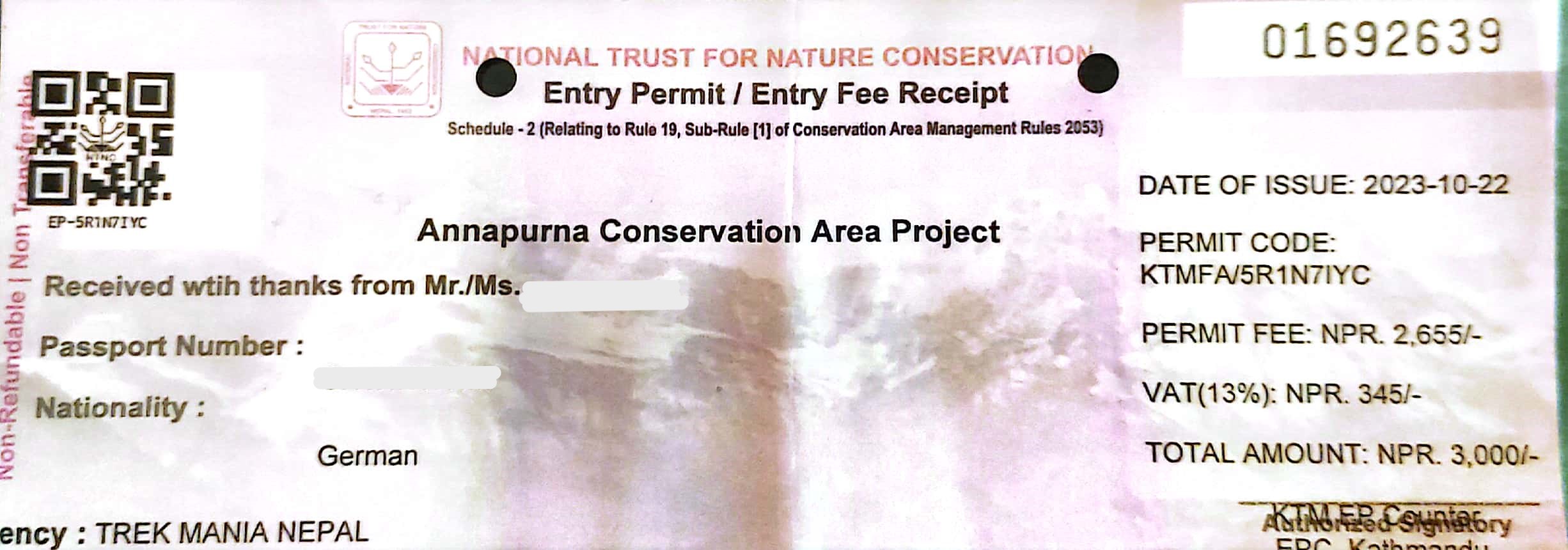
2. Trekker's Information Management System(TIMS):
For hikers in Nepal, the TIMS (Trekker's Information Management System) card is a necessary piece of identification. It was put into place to improve trekkers' safety and security while also assisting authorities in keeping track of travelers in various hiking locations.
Cost: Nrs 2000 per person for non SAARC tourists and Nrs 1000 for SAARC trekers.
3. Climbing permit:
A climbing permit is a legal authorization or license issued by a relevant body or organization to individuals or groups that authorizes them to climb a certain mountain, or designated climbing area. These climbing permits differ according to the region and the governmental agency in charge of the area.
Cost: Climbing permits are priced differently depending on the season. For the months of March, April, and May, the cost is USD $250 due to the ideal conditions of clear and mild weather. On the other hand, during September, October, and November, the permit fee is USD $125 for the autumn season, which is a popular time for Tent Peak Climbing. The permit price decreases during the winter and summer months, which are considered off-seasons. Additionally, for December, January, and February, the permit fee is USD $70.
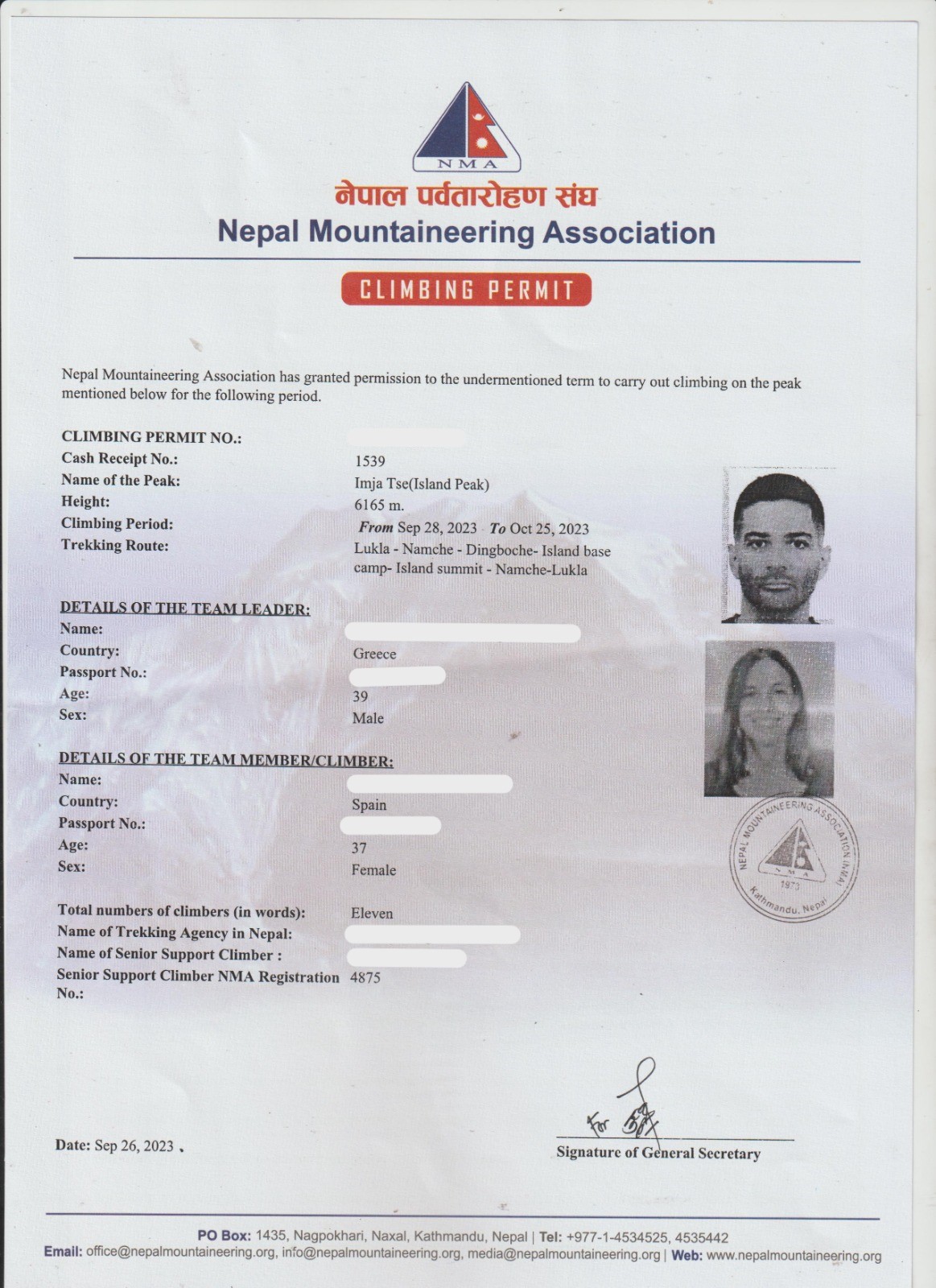
(All the permits required are included in this package).
4. Travel insurance:
Peak climbing travel insurance is a type of specialized travel insurance that covers people who go on high-altitude mountaineering or climbing expeditions to peaks like Tent Peak or other Himalayan summits. This is required for safety and is tailored to the unique risks and challenges of high-altitude climbing adventures.
Necessary documents for Permits:
- You will only need your valid passport photocopy(validity of 6 months).
- Passport-size photos 2p.
- Travel insurance papers (includes helicopter evacuation of up to 6000m)
Highlights
- Spectacular views of the Annapurna and Dhaulagiri mountain ranges.
- Diverse terrain, from lush forests to rocky alpine meadows.
- Cultural interactions with Gurung and Magar villages.
- Trekking and non-technical mountaineering combined.
- Glacier travel experience.
- Breathtaking sunrise views from the summit.
- Rich cultural heritage, including monasteries and prayer flags.
- Chance to spot Himalayan wildlife during the trek.
Cost Details
- Two-night Deluxe hotel in Kathmandu.
- Kathmandu–Nayapul-Kathmandu transport.
- Tent Peak Climbing Permit.
- Included Garbage disposal charge.
- Annapurna Conservation Area Entry Permit.
- One climbing guide (Sherpa) among two members.
- All Ground transport as per the itinerary.
- All standard Meals (Breakfast, Lunch, and Dinner) throughout the trek and climb.
- Breakfast in Kathmandu.
- Accommodation in a lodge during the trek and basic camping arrangements during climbing.
- A porter for every two passengers (please make your bag 15 kg and around).
- Insurance for every staff
- Tent Peak Climbing Map.
- Emergency Helicopter rescue arrangement if in case (pay by your travel insurance) in the worst case only).
- Sleeping, bag down jackets if you do not have your own, to be returned after the trip.
- First Aid Box carried by the porter.
- Seasonal Fruits throughout the trek.
- Medical supplies, first aid kit box, including Oximeter and pulse meter checker.
- All other government taxes and expenses
- Personal clothing, gear and climbing equipment.
- Personal accident insurance, emergency evacuation cost, oxygen, medical box.
- Alcoholic beverage, laundry and tips.
- Extra night Hotel accommodation and sightseeing tour in Kathmandu (available as per your choice)
Equipment List
Checklist for Tent Peak Climbing
For Head
· Balaclava that covers your ears
· Headlamp with extra batteries and bulbs
· Bandana or headscarf, very useful for dusty conditions
· Beanie
· Wide brimmed sunhat
· Neck gaiter or warmer
· Snow goggles and Sunglasses with UV protection (carry an extra pair in case you lose or break it)
· Prescription sunglasses (if required)
For Upper Body
· T-shirt (moisture absorbing and breathable)
· The thermal base layer of merino wool
· Fleece wind-stopper jacket or pullover
· Waterproof (preferably breathable fabric)
· Long sleeve shirt (moisture absorbing and breathable)
· Shell jacket
· Down Vest
· Expedition weight insulated down jacket with hood (not required for all trekking peaks )
· Gore-Tex jacket with hood, waterproof and breathable
For Hands
· A pair of lightweight poly-liner gloves or lightweight wool or fleece gloves
· Summit Mittens (warm insulated gloves with safety straps)
For Lower Body
· Lightweight thermal leggings of merino wool
· Trekking trousers (waterproof, breathable fabric)
· Hardshell trousers
· Non-cotton underwear briefs
· Hiking shorts
· Synthetic insulated pants
For Feet
· Crampons
· Lightweight inner socks, heavy poly or wool socks and cotton socks
· Running shoes and rubber sandals/flip-flops
· Double insulated climbing boots
· Good quality hiking boots (sturdy soles, water-resistant, ankle support, “broken-in”)
· Gaiters
For Sleeping Purpose
· Sleeping Bag ( a 5 season sleeping bag, suitable for temperatures for as low as -40°C)
· Foam pad
· Fleece sleeping bag liner
· Therm-a-Rest sleeping pad (NeoAir XTherm) which offers insulation and warmth in sub-freezing temperatures
· Pillowcase
Personal Climbing Gears
· Ice axe
· Crampons
· Ascender/Jhumar
· Prusik rope
· Helmet
· Harness
· Tape slings (2)
· Screwgate karabiners (2 locks, 2 unlock)
· Descender/eight figure
· Plastic mountaineering boots
Group Climbing Gears
· Snow bar
· Rope
· Ice hammer
· Ice screw
Baggages
· Rucksack and Travel Bags
· A small daypack/backpack(30-40L) for carrying your valuables should have good shoulder padding.
· Large duffel bag (80-100L)
· Small padlocks for duffel-kit bags
· Waterproof covers
Medical
· Small, personal first-aid kit (simple and light)
· Paracetamol
· Cough and/or cold medicine
· Anti-altitude sickness pills - Diamox or Acetylzolamide
· Stomach antibiotic - Ciprofloxacin, etc. Do not bring sleeping pills as they are a respiratory depressant.
· Aspirin, first-aid tape, and plasters (Band-Aids)
· Skin-blister repair kit
· Anti-diarrhea pills
· Throat lozenges
· Water purification tablets or the water filter
· Earplugs
· lip guard
· Eye drops
· Extra pair of prescription glasses, contact lens supplies
· Sunscreen
Practical Items
· Alarm clock/watch
· Camera with extra SD cards and batteries
· Large Ziploc bags
· 2 water bottles (1 liter each)
· Small roll of repair tape, sewing-repair kit
· Binoculars (optional)
· 4 large, waterproof, disposable rubbish sacks
· Socket adapter Type C (with circular pins)
· Cigarette lighter / small box of matches
· Compass or GPS(optional)
· Lightweight steel thermal bottle
· Small folding or Swiss knife
· Trekking poles(foldable)
Toiletries
· Small sachets of shampoo
· Deodorants
· Nail clippers
· Face and body moisturizer
· Female hygiene products
· Small mirror
· Medium-sized quick-drying towel
· Toothbrush/paste (preferably biodegradable)
· Multipurpose soap (preferably biodegradable)
Personal Hygiene
· Anti-bacterial handwash
· Hand sanitizer
· Pee Bottle (1 litre, leak-proof, wide mouth)
· Pee funnel (for female)
· Wet wipes (baby wipes)
· Tissue /toilet roll
Extras/Luxuries
· Reading book
· Trail map/guide book
· Journal and pen
· iPod
· Playing cards (to help you pass the time at teahouses and/or camps)
· A modest swimsuit
· Binoculars (optional)
FAQs
Tent Peak, also known as Tharpu Chuli (5,695m), is a perfect peak for beginner climbers looking to gain high-altitude mountaineering experience while enjoying stunning views of Annapurna, Machapuchare, and Hiunchuli.
The climb involves steep snow slopes, icy ridges, and technical sections, requiring the use of ropes, crampons, and ice axes, making it a moderate-level trekking peak.
The entire expedition takes around 16–18 days, including trekking through the Annapurna Sanctuary, proper acclimatization, and the final summit push from High Camp.
Climbers should have prior trekking experience and be comfortable with basic mountaineering skills, including walking on snow and ice, using crampons, and handling an ice axe.
Tent Peak offers a thrilling mountaineering experience without requiring extensive technical skills or expensive permits, making it an ideal choice for those looking to progress from trekking to climbing.


